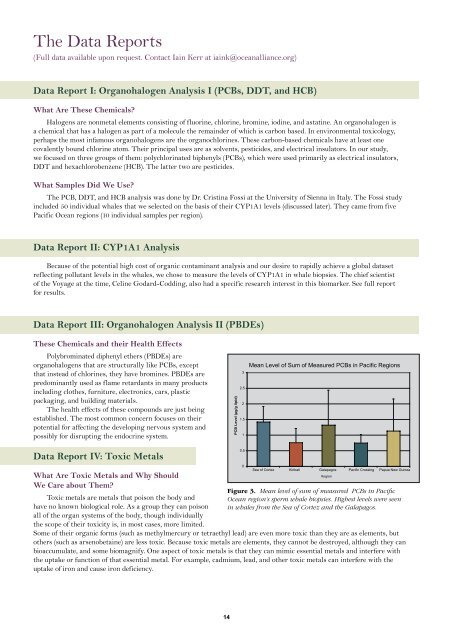Voyage of the Odyssey executive summary - Ocean Alliance
Voyage of the Odyssey executive summary - Ocean Alliance
Voyage of the Odyssey executive summary - Ocean Alliance
You also want an ePaper? Increase the reach of your titles
YUMPU automatically turns print PDFs into web optimized ePapers that Google loves.
The Data Reports<br />
(Full data available upon request. Contact Iain Kerr at iaink@oceanalliance.org)<br />
Data Report I: Organohalogen Analysis I (PCBs, DDT, and HCB)<br />
What Are These Chemicals?<br />
Halogens are nonmetal elements consisting <strong>of</strong> fluorine, chlorine, bromine, iodine, and astatine. An organohalogen is<br />
a chemical that has a halogen as part <strong>of</strong> a molecule <strong>the</strong> remainder <strong>of</strong> which is carbon based. In environmental toxicology,<br />
perhaps <strong>the</strong> most infamous organohalogens are <strong>the</strong> organochlorines. These carbon-based chemicals have at least one<br />
covalently bound chlorine atom. Their principal uses are as solvents, pesticides, and electrical insulators. In our study,<br />
we focused on three groups <strong>of</strong> <strong>the</strong>m: polychlorinated biphenyls (PCBs), which were used primarily as electrical insulators,<br />
DDT and hexachlorobenzene (HCB). The latter two are pesticides.<br />
What Samples Did We Use?<br />
The PCB, DDT, and HCB analysis was done by Dr. Cristina Fossi at <strong>the</strong> University <strong>of</strong> Sienna in Italy. The Fossi study<br />
included 50 individual whales that we selected on <strong>the</strong> basis <strong>of</strong> <strong>the</strong>ir CYP1A1 levels (discussed later). They came from five<br />
Pacific <strong>Ocean</strong> regions (10 individual samples per region).<br />
Data Report II: CYP1A1 Analysis<br />
Because <strong>of</strong> <strong>the</strong> potential high cost <strong>of</strong> organic contaminant analysis and our desire to rapidly achieve a global dataset<br />
reflecting pollutant levels in <strong>the</strong> whales, we chose to measure <strong>the</strong> levels <strong>of</strong> CYP1A1 in whale biopsies. The chief scientist<br />
<strong>of</strong> <strong>the</strong> <strong>Voyage</strong> at <strong>the</strong> time, Celine Godard-Codding, also had a specific research interest in this biomarker. See full report<br />
for results.<br />
Data Report III: Organohalogen Analysis II (PBDEs)<br />
These Chemicals and <strong>the</strong>ir Health Effects<br />
Polybrominated diphenyl e<strong>the</strong>rs (PBDEs) are<br />
organohalogens that are structurally like PCBs, except<br />
that instead <strong>of</strong> chlorines, <strong>the</strong>y have bromines. PBDEs are<br />
predominantly used as flame retardants in many products<br />
including clo<strong>the</strong>s, furniture, electronics, cars, plastic<br />
packaging, and building materials.<br />
The health effects <strong>of</strong> <strong>the</strong>se compounds are just being<br />
established. The most common concern focuses on <strong>the</strong>ir<br />
potential for affecting <strong>the</strong> developing nervous system and<br />
possibly for disrupting <strong>the</strong> endocrine system.<br />
Data Report IV: Toxic Metals<br />
What Are Toxic Metals and Why Should<br />
We Care about Them?<br />
Toxic metals are metals that poison <strong>the</strong> body and<br />
have no known biological role. As a group <strong>the</strong>y can poison<br />
all <strong>of</strong> <strong>the</strong> organ systems <strong>of</strong> <strong>the</strong> body, though individually<br />
<strong>the</strong> scope <strong>of</strong> <strong>the</strong>ir toxicity is, in most cases, more limited.<br />
Some <strong>of</strong> <strong>the</strong>ir organic forms (such as methylmercury or tetraethyl lead) are even more toxic than <strong>the</strong>y are as elements, but<br />
o<strong>the</strong>rs (such as arsenobetaine) are less toxic. Because toxic metals are elements, <strong>the</strong>y cannot be destroyed, although <strong>the</strong>y can<br />
bioaccumulate, and some biomagnify. One aspect <strong>of</strong> toxic metals is that <strong>the</strong>y can mimic essential metals and interfere with<br />
<strong>the</strong> uptake or function <strong>of</strong> that essential metal. For example, cadmium, lead, and o<strong>the</strong>r toxic metals can interfere with <strong>the</strong><br />
uptake <strong>of</strong> iron and cause iron deficiency.<br />
14<br />
PCB Level (µg/g lipid)<br />
3<br />
2.5<br />
2<br />
1.5<br />
1<br />
0.5<br />
0<br />
Mean Level <strong>of</strong> Sum <strong>of</strong> Measured PCBs in Pacific Regions<br />
Sea <strong>of</strong> Cortez Kiribati Galapagos<br />
Region<br />
Pacific Crossing Papua New Guinea<br />
Figure 3. Mean level <strong>of</strong> sum <strong>of</strong> measured PCBs in Pacific<br />
<strong>Ocean</strong> region’s sperm whale biopsies. Highest levels were seen<br />
in whales from <strong>the</strong> Sea <strong>of</strong> Cortez and <strong>the</strong> Galapagos.


